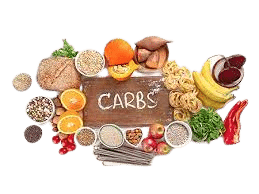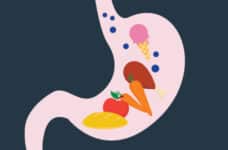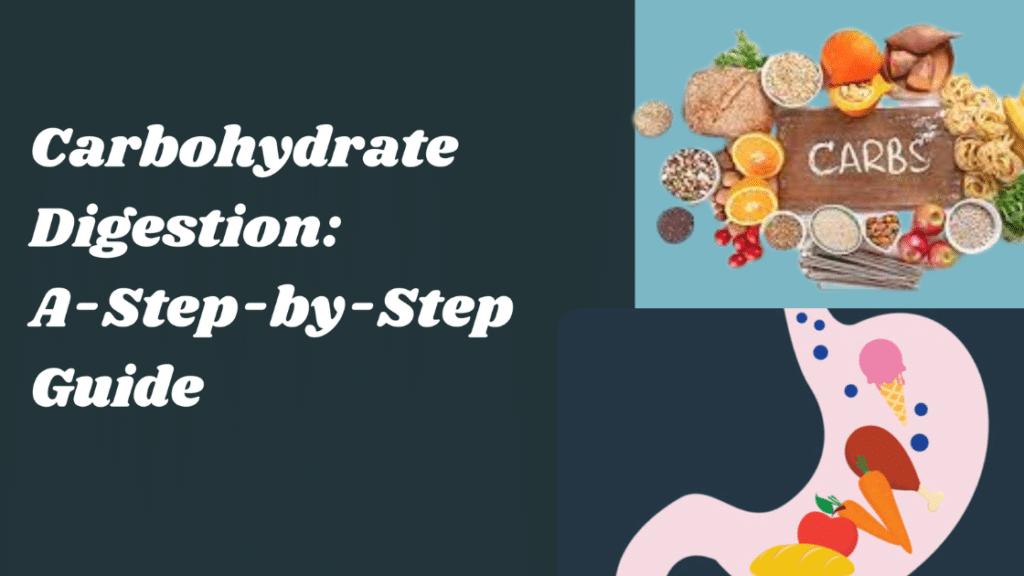Table of Contents
Introduction to carbohydrate digestion
Learn about Carbohydrate Digestion- A Step-by-Step Guide, enzymes involved, and end products obtained from healthy and processed carbohydrates.
- In this article you will learn about:
- Micronutrient rich and micronutrient deficient carbohydrates;
- How carbohydrates are digested in the body?;
- What are the enzymes involved in digestion of carbs?
- The end products obtained after digestion of healthy cars and poor carbs.
Carbohydrate types

There are two types of carbohydrates – processed and unprocessed. What is the difference? In whole grain the the nutrients present in the outer coating of the grain and fiber are also present after digestion. They are micronutrient and fiber rich carbohydrates. In processed carbohydrates, the vitamins and minerals and fiber are removed during processing making the carbohydrates poor in micronutrients (unhealthy carbs)
When a rice or wheat seed is planted in the field, it germinates and grows into a plant. It is able to grow because it is able to use the vitamins and minerals present in the seed to generate energy from the starch present in the endosperm. It is rich in carbohydrates, proteins and lipids and provides nourishment to the growing embryo.
Similar to this our body also needs vitamins and minerals for the metabolism of carbohydrates to produce energy. Vitamins are used in the form of coenzymes and minerals are used in the form of cofactors. Digestive enzymes, coenzymes and cofactors are necessary for metabolism to produce energy.
Drawbacks of poor diet: Imagine using micronutrient deficient food like polished rice, white flour and its products and sugar and sugary drinks, every day, year after year. How can body tolerate the food without micronutrients? It is very difficult. The net result is suffering from chronic diseases.
This blog article on carbohydrate digestion is specifically to educate you on this point: the importance of vitamins, minerals and fiber in achieving or maintaining good health, prevent heart diseases and other chronic diseases.
Think of carbohydrates beyond Fiber content
You will find many Youtubers talking about fiber content in carbs as the best carbs to eat. This is a misleading information. After digestion the fiber goes to the large intestine and gets eliminated. It is an inactive compound and has no other function apart form providing bulkiness to the waste material.
People make a mistake in choosing the right carbohydrates that helps them keep healthy. They select carbs rich in fiber. Carbohydrates rich in micronutrients should be the choice in selecting the right carbohydrates. Digestion of micronutrient rich carbohydrates produces micro nutrient rich glucose, galactose, and fructose.
The glucose that is available to the body to produce energy contains micronutrients. These micronutrients are essential for the further breakdown of glucose in the cells to produce energy.
Mistakes people make in selecting carbohydrates
Proper information is not available to people as to which carbohydrates are healthy for them. People give importance to the number of calories present in carbs, rather than the micronutrients present.
They believe weight loss is achieved by eating low carb diet.
The following diets are popular:
- Low- carbohydrate diets
- Low glycemic index carbohydrates
- Avoid high glycemic index food
- Low carb low fat Diets
- Carbs that have a high fiber content
- Switch from wheat to millet
There are several other diets that recommend a low carb diet.
Thinking is limited to the macronutrient carbohydrate
Starch is the main macronutrient present in carbohydrates along with 10% proteins and some fats. People select carbohydrates based on taste or palatability, like pizza, cakes, cookies, bread, ice cream, sugary drinks, and pasta. They consider it as only the source of energy.
Most of these items are made from white flour. White flour is devoid of nutrients like vitamins and minerals. Even if present the quantity is very less.
White flour is made by polishing the outer layer of the grains like wheat and rice. After polishing the grains look white in color. But they are devoid of nutrients like vitamins and minerals. These vitamins and minerals are present on the outer layer of the grain and are removed during the polishing operation.
The end product after digestion is simple sugars like glucose, galactose, and fructose. For simplicity, we can consider glucose as the main sugar obtained after digestion.
If you use processed white flour, white rice, or processed grains then after digestion you will end up with Glucose with no micronutrients in it (unhealthy diet).
If you use whole grains the end product of digestion will be Glucose with micronutrients present in it. (healthy diet).
Glucose is the fuel now ready to be used by the body for performing all its functions.
What happens after carbohydrate digestion?

Your digestive system has digested the carbohydrate and produced the main fuel “GLUCOSE”, with little fructose and galactose.
You assume you have eaten healthy food and that you are ok.
What happens after carbohydrate digestion is given less importance? At the most they know that glucose is formed after digestion in the digestive system. Then it enters the bloodstream and is supplied to all the cells in the body.
After reaching the cells how it is converted to energy is known to only a few people. The aim of this article is to educate the common man on what happens to glucose in the cells. How it is metabolized, what are the requirements for metabolism to occur, and so on.
This type of information will help them understand what actually healthy food is. Healthy food is not just a bunch of macronutrients.
What are different types of carbohydrates?
|
Carbohydrates |
||
|
Simple |
Complex |
|
|
Monosaccharides |
disaccharides |
Polysaccharides |
|
Glucose |
sucrose |
starches |
|
fructose |
lactose |
fiber |
|
galactose |
maltose |
glycogen |
Fig :Types of carbohydrates
Carbohydrates, or carbs, are sugar molecules having complex structures. Along with proteins and fats, carbohydrates are one of the three main nutrients found in foods and drinks.
There are three main types of carbohydrates:
Polysaccharides Starches
Starches are complex carbohydrates, which are made of lots of simple sugars attached together to form a complex molecule. Your body needs to break starches down into sugars to use them for energy. Starches include bread, cereal, pasta, wheat, millet, and rice. They also include certain vegetables, like potatoes, peas, and corn.
Disaccharides
These are sugars like sucrose, lactose, and mannose. They contain two sugar units bound to each other forming a disaccharide. They can be added to foods, such as the sugar in candy, desserts, processed foods, and regular soda. They also include the kinds of sugar that are found naturally in fruits, vegetables, and milk.
Fiber
Fiber is also a type of polysaccharide that is more complex and not easily digestible. Fiber is found in many foods that come from plants, including fruits, vegetables, nuts, seeds, beans, and whole grains.
———————————————————————————————————————————-
How Digestion of digestion takes place?
Carbohydrate digestion by Digestive system
Our bodies are made up of 11 basic organ systems that manage all the essential body functions. The function of the digestive system is to digest the food that we eat.
The digestive system includes the mouth, pharynx (throat), esophagus, stomach, small intestine, large intestine, rectum, and anus. It also includes the salivary glands, liver, gallbladder, and pancreas, which make digestive juices and enzymes that help the body digest food and liquids.
Carbohydrate digestion in mouth
Digestion of food starts in the mouth. The food begins to break into smaller pieces in the mouth. The smaller pieces get mixed with the saliva, produced by several salivary glands in the body.
The enzymatic digestion of starch occurs in the mouth. The PH in the mouth is slightly alkaline. The salivary amylase enzyme breaks the long glucose chain of starch into shorter polysaccharides and disaccharides like maltose.
Other ingredients like protein are not digested in the mouth.
Starch
|
Starch (Polysaccharide) |
|
Salivary Amylase enzyme |
|
Shorter polysaccharides
G-G-G-G-G-G-G-G-G ( 8 SUGAR UNITS) G-G-G-G (4 SUGAR UNITS) G-G ( Maltose ; 2 sugar units |
Fig: The enzyme salivary amylase breaks starch into smaller polysaccharides and maltose.
Carbohydrate digestion in the stomach
The PH in the stomach is low i.e. it is highly acidic. At this PH the digestion of carbohydrates does not take place.
In acidic PH proteins get digested.
The food then passes in the intestine for further digestion.
Carbohydrate digestion in intestine
The PH in the intestine is alkaline. Most carbohydrate digestion occurs in the small intestine.
An enzyme called pancreatic amylase is secreted from the pancreas into the small intestine. It breaks starch down to small oligosaccharides (containing 3 to 10 glucose molecules) and maltose.
The rest of the work of carbohydrate digestion is done by enzymes produced by the enterocytes, the cells lining the small intestine. There are different enzymes to convert different disaccharides to monosaccharides.
Maltase
Maltose is digested by the enzyme maltase to 2 glucose molecules.
Lactase
Lactose is digested by the enzyme lactase, forming glucose and galactose.
Sucrase
Sucrose is digested by the enzyme sucrose, forming glucose and fructose.
By the end of this process of enzymatic digestion, we’re left with three monosaccharides: glucose, fructose, and galactose. These can now be absorbed across the enterocytes of the small intestine and into the bloodstream to be transported to the liver.
Conclusion
Digestion of carbohydrates or starch produces glucose, galactose or fructose, micronutrients which on absorption through intestines is transported to liver. In the liver galactose and fructose is converted to glucose.

